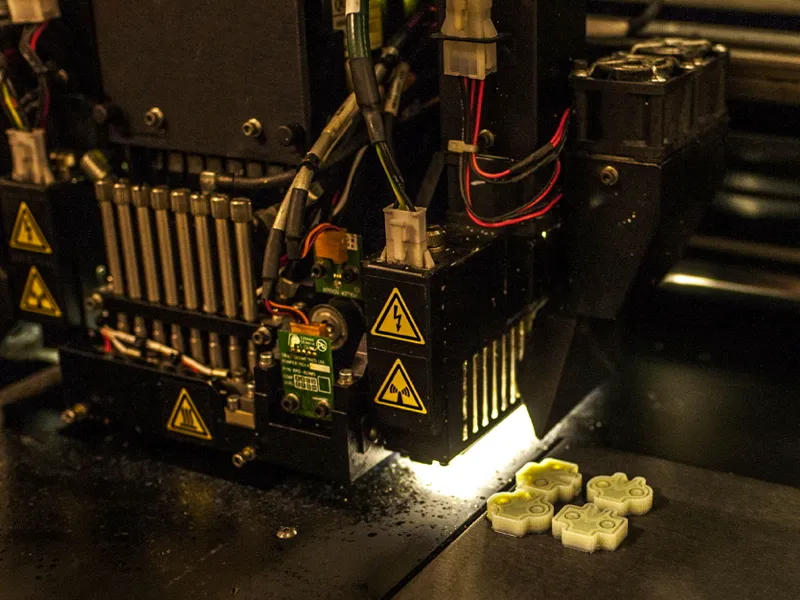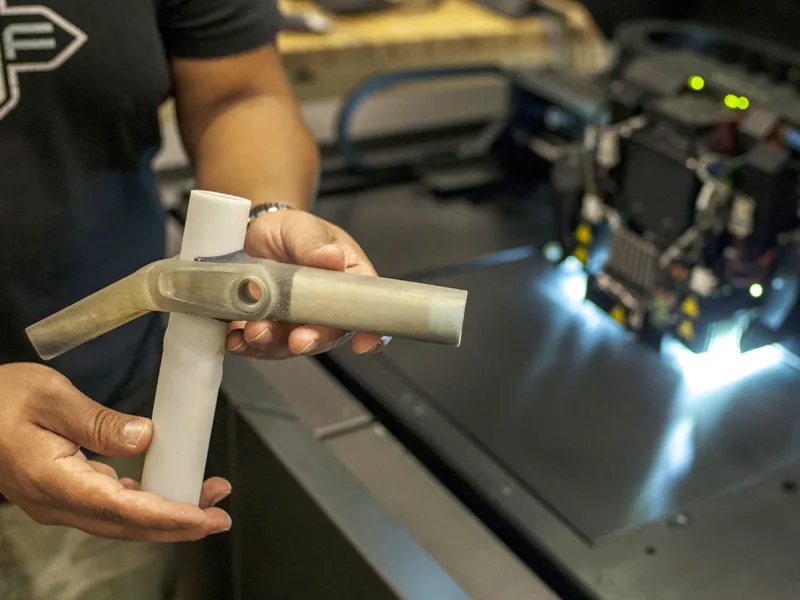Could you ride a bicycle that came out of a printer?
Today, 3D printing is very much helping the way bicycles are designed. Many bicycle manufacturers are finding benefits of the technology, using 3D printers to build prototypes of parts.
While it might sound like a brand new technology, the first 3D printer was based around a technique called sterolithography that was invented in 1984. This used a UV laser beam to trace a slice of an object on the surface of a liquid, which caused a thin layer to harden. With each pass the object is built up.
Today there are several methods of 3D, which are all based around additive technology. In this system objects are built up in layers that are bonded or otherwise fused together and the process can take several minutes or even hours to complete.
But for designers being able to see an actual product – even as a mockup – in the real world in a minutes or hours sure beats the time it could take to craft something in metal.
“We use a 3D printer all the time,” said Eric Bjorling, Trek Bicycle spokesman. “Not a cheap piece of equipment but pretty amazing to see it work. That thing can make some crazy shapes.”
And seeing those shapes in the flesh is unlike just relying on a 3D image on a computer screen.
“I can’t say it has made any major changes in the way bikes are designed, but it sure has improved the ability to have a rapid prototype in your hands,” Brad DeVaney of product design and development with the American Bicycle Group told BikeRadar. “With that being said, improved availability of prototypes does result in more refined designs.”
Road.cc recently published a story on how Charge BIkes and EADS are printing dropouts with titanium.

Trek's 3D printer in action, laying down layer on layer of plastic
Faster Designs
While the use of 3D printing isn’t likely making the bikes faster, it is speeding the development. Designers can go from transforming a design that exists on the screen screen to seeing a real 3D model in a short amount of time.
“The new 3D CAD software has been more important from his point of view,” explains Alessandro Colnago, vice president of Colnago. “The big advantage of the 3D printing is that you can make better controls before opening the mold. Some clearances, cable routing and other details that are difficult to verify with 3D software are easily controlled with 3D printing.”
There are some things that still stand in the way Colnago told BikeRadar.
“Unluckily not all the components are available as 3D drawings, some manufacturers don’t release them,” he said.

Trek printed out the IsoSpeed junction in 3D
But even just being able to streamline the process can be very helpful for those doing the design work.
“For Giant, the speed of 3D printing the models, then evaluation and then refinement and/or validation – under the same roof as the manufacturing process - is almost instantaneous,” explained Giant’s in-house industrial designer, Erik Klemm. “Giant goes through several steps in the design process to develop 3D models – when the engineers get to the form, details and how they come together. But there is a need for the designers and engineers to hold the product in their hands and see the physical form factor in person.”
Next Best Thing to a Production Bike
Many companies can now use the 3D printing and essentially create a finished bike, albeit one that isn’t really rideable. But it can provide visual feedback and now what a real finished product will look like when it’s done.
“For frames, Giant will print out the frame sections, assemble them, paint and then evaluate the physical frame structure,” added Klemm. “Giant can also assemble components and parts onto a frame to check for fit, and evaluate the geometry of the bike as well for validation on the design direction. The benefits are a much faster and more affordable design and development process.”
Being a giant in the industry, not to mention a vertically integrated company with the in-house engineering team under the same roof as the factory that manufactures the bicycles in Taiwan, only further allows Giant to take advantage of the 3D printing.
“The 3D printing machine on-site in Taiwan is located next to the design and engineering team,” Klemm told BikeRadar. “It provides Giant engineers with instantaneous feedback that is critical in bicycle product design. Bicycle products that benefit from the models created by this machine include Giant-designed frame sets, wheel systems and a variety of bicycle components.
So what about the next step; could Giant or any other company actually print out bike frames? The process could be on the cusp of seeing real world development.

Compared to machining metal, printing plastic is easy
3D Printing as an Actual Piece of Equipment
French designer Luc Fusaro has developed a technique that would allow for printing of customer-fitted track shoes, and he has developed a 3D scanning system to perfectly match an athlete’s foot. Shoes are then printed out via an SLS (selective laser sintering) process that produces the strongest products from additive manufacturing. But this is still just shoes, not a bike.
The problem could the size of the printers involved – at least for now.
“Industrial scale is a big number so that will be hard,” said futurist Glen Hiemstra. “We probably need to go out decades before there would be enough 3D printers owned widely enough that large numbers - tens of thousands - of anything will be delivered via such printers.”
But never say never.
“I have little doubt that this will be the future someday,” Hiemstra told BikeRadar. “As for materials, as nanoscale carbon composite tech continues to develop, producing things like bikes with sufficient strength will not be an issue. Scale will be the issue.”
While Hiemstra says that for now 3D printing will be utilized mostly for delivery of designs, production of prototypes, it is just a matter of time. But how much time is the question.
“Maybe we are talking 200 years to go,” he said. “But more like 50 years, maybe 30 years.”